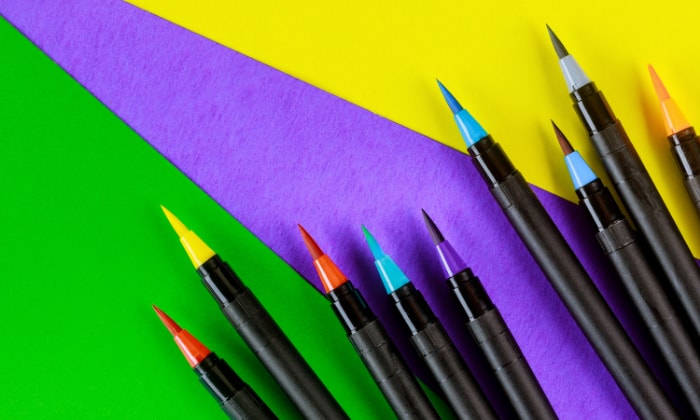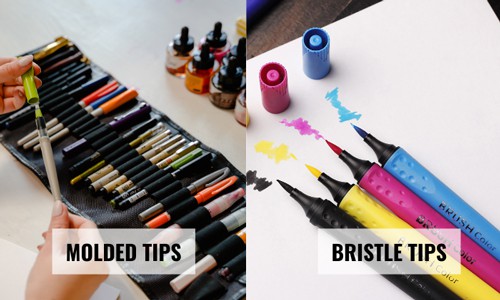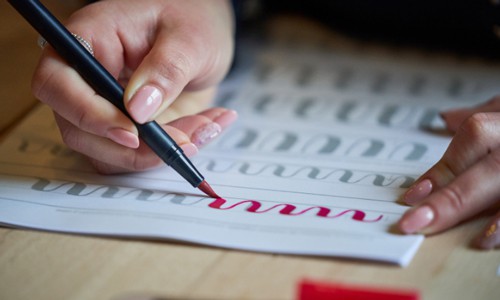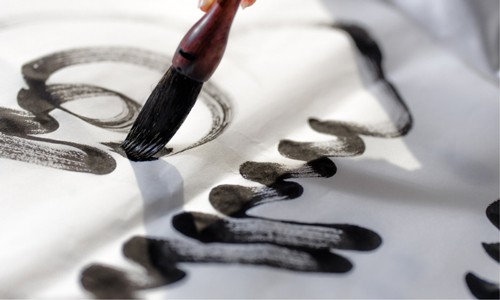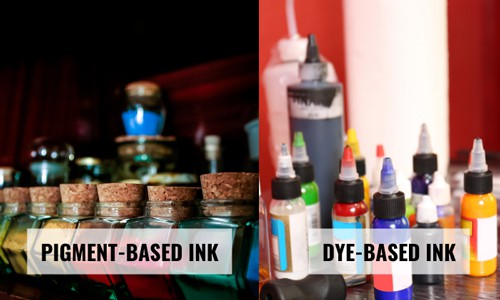If you’re fond of calligraphy, you’re probably familiar with brush pens. However, most of the time brush pens are confused with brush markers and think that they’re just the same, but no, they’re certainly not.
So, what is a brush pen, then? Brush pens are more like fountain pens, except that they don’t have metal nibs but a brush tip, while brush markers are markers with brush tips with ink filament.
Now it’s time to learn more about brush pens!
Table of Contents
Understanding Brush Pens
A brush pen is a writing or drawing tool that combines the traditional pen with the expressive qualities of a brush.
- It typically consists of a barrel similar to that of a regular pen. However, instead of a ballpoint or felt tip, it features a flexible brush-like tip made from materials such as synthetic bristles or foam.
- Brush pens also come in various forms, from disposable models to refillable ones where you can replace the ink cartridge or reservoir. The ink used in brush pens can also vary, depending on the intended purpose.
The brush tip allows for a wide range of strokes, from thin lines to thick, bold strokes, similar to what you can achieve with an actual paintbrush. This versatility makes brush pens popular among artists, calligraphers, illustrators, and anyone who enjoys creative writing or drawing.
Brush pens are great for hand lettering, comic book illustration, manga art, sketching, and more. They offer greater control compared to traditional brushes and ink.
Factors Affecting Brush Pen Functions
Construction and Material
1. Tip Materials
Brush pens come in various tip types divided into two major categories: bristle brush tips and molded felt tips.
- Bristle Tips
The bristles can have strands of synthetic or natural hair fibers. Synthetic brushes are mostly made out of polyester or nylon, while natural hair fibers come from animal hair, typically from sable, weasels, squirrels, or many others.
Brushes with natural fibers are known to have a fine grain and consistent pointy tips. It is also more reactive and somehow gives you the feel of using a real paintbrush. However, that could also mean they are harder to control and require a steeper learning curve.
- Molded Tips
Preformed tips are made with felt most of the time. It is produced using compacted synthetic fibers and rubber.
Because of its composition, felt tips tend to be stiffer than brushes with individual bristles. This characteristic can be an advantage for beginners. It makes the brush easier to handle.
Moreover, some rubber tips are engineered to mimic natural brush tips’ softness, flexibility, and other qualities.
2. Tip Sizing
Brush pen tips are usually available in fine, medium, and broad sizes. In addition, other brands define their sizes uniquely depending on how thick the brush is.
- Fine: Good for detailing and putting up with small spaces or angles. It can give you the smallest line variation. Some brands offer extra fine brushes that give you a super fine point. Ideal for writing with brush pens.
- Medium: If you do not have a specific size in mind, this is a good size. It can produce thick and thin strokes and other strokes in between. You can use it to sketch an illustration and color with them as well.
- Broad: This is mostly used for shading and filling large areas. It is generally used to deal with large projects and bolder artworks.
3. Firmness and Elasticity
How a brush pen reacts and moves when pressure is applied depends on how firm and elastic your brush pens are.
Firmness refers to how compact the brush is, in other words, how soft or hard it is. On the other hand, elasticity is the ability of the brush to bounce back without being deformed. The combination of these features will also tell you how controllable and easy they are to handle.
In general, if you have a heavy hand, you would want to have a hard tip. Soft tips are normally more flexible than hard tips.
Much like using soft-tip markers, soft-tip brush pens require great control. If you have good hand reflexes and like to make bold lines with less effort, then a soft-tip brush pen will work perfectly fine.
When it comes to elasticity, firm tips are more elastic. Moreover, it may also be affected by the material type. Synthetic brush pens with rubber tips typically give you more bounce than the bristle type, which requires reshaping from time to time.
4. Ink Supply
Apart from the qualities of the brush, the rate of ink supplied to the brush is another factor that affects the output of your brush pen. This refers to the flow rate of ink, which is classified into wet, medium, and dry.
The wet type is generally preferred if you want to go fast with your brush lettering pens without streaking, but due to the consistent ink supply, the risk of getting blots and smudges is higher.
Ink flow for medium and dry tips is more controlled. With that, it is less likely to blot even if you go slower. Moreover, they can get streaky and inconsistent.
In addition, keep in mind that getting too much ink or dried-out ink can be caused by the wrong storage. Storing it tip down can cause the ink to pool into the brush while storing it tip up or leaving it uncapped can cause drying.
To avoid these issues, you can horizontally store your brush pens. You may also check the packaging for storage recommendations.
5. Ink Properties
The characteristics of the ink have an overall say on the stability of your brush pen artwork. If you want it to last longer, look for brush pens with pigment-based ink rather than dye-based ink.
Pigment-based ink is said to have archival qualities like being lightfast, while dye-based ink is not expected to last.
You would also want to know the solubility, especially when you want to use different brush pen techniques or use it with other coloring mediums.
For example, if you use brush pens for drawing or sketching before coloring with watercolors and markers, then you want a brush pen that is both alcohol and water-resistant.
6. Refill Options
In the beginning, we mention the brush pen definition being similar to a fountain pen in a manner that it can be refilled. Moreover, not all brush pens are designed to be refillable. For the refillable type, there are three options to choose from.
- Cartridge type – lock and load type; no need to do a manual refill.
- Squeeze type – needs a manual refill. The barrel holds more ink. It is made with soft plastic that you can press to release ink whenever the tips feel dry.
- Piston type – has to be refilled from the bottle as you would normally do in piston filler fountain pens.
Conclusion
Hope this one helps you understand what is a brush pen. Now it’s finally fitting to get one and experience it with your own hands.
Brush pens aren’t as complicated as fountain pens, but you must consider different factors and see how they match your style or application.
For example, if you love paintbrushes and consider brush pens as an alternative, you’d want to look for a brush pen with bristles, or if you plan to use brush pens for calligraphy and want to achieve that hairline transition, a small tip brush pen could be all you need.

Art has always been a part of my life; it influences my upbringing and later my career choice. For me, it is always a part of my parenting technique. So for whichever purpose that you come to art, you can start here with us.

